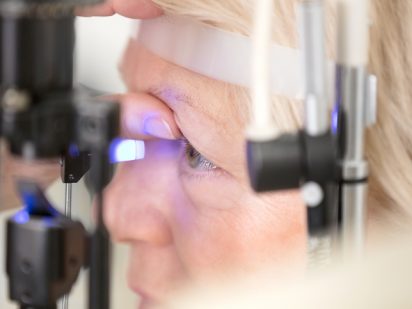A “floater” is a condensation of vitreous humor, the clear gel that fills the space between the lens and the retina of the eye. This gel can separate from the retina and form into clumps, which are perceived in the line of vision as a floater.
Floaters occur more commonly as you get older, explained David Jacobs, MD, an ophthalmologist and vitreoretinal surgeon with Trinity Regional Eyecare – Minot Center. According to Mayo Clinic, being over the age of 50 is among the risk factors for floaters. (Other risk factors include nearsightedness, eye trauma, complications from cataract surgery, diabetic retinopathy, and eye inflammation.)
The National Eye Institute indicates that most people have floaters but learn to ignore them, mainly because they are not as numerous or prominent. However, when they do become prominent – to the point that vision is impaired – they can become a problem.
A low-risk treatment for floaters is now available at Trinity Regional Eyecare – Minot Center. YAG laser vitreolysis, which breaks up the floaters during an in-office procedure rather than an operating room, takes about 10 to 20 minutes. In 2017, Trinity Regional Eyecare – Western Dakota in Williston upgraded its cataract laser to include the YAG laser vitreolysis technology.
Karen Philion, of Minot, first learned of the procedure after reading about how Williston offered the service. It sounded like something she needed. About a year and a half ago, Philion noticed a floater that was shaped “like a musical note,” she said. “It was kind of big.” After consulting with Dr. Jacobs, she learned that he could do the procedure in Minot.
The procedure appears to be like a standard eye exam: a patient sits in the chair while the doctor looks in the eye with a slit lamp, a biomicroscope. Prominent floaters are identified and severed with the laser. The YAG laser vitreolysis cuts the floater into tiny pieces so it is less noticeable and doesn’t affect the central vision as much.
Dr. Jacobs compares the surgery to a boulder in a driveway. “If you can imagine you have a boulder in your driveway, if you cut it up in tiny pieces and turned it into gravel, it would no longer be a problem,” he said.
He noted that the treatment may take two to three laser sessions to completely break up the floater. “We typically perform the procedure, and then bring the patient back a month later,” he said. “If the floater is still there, we will do it again.”
Philion, who said that she did not feel any pain during the procedure, now has less of an obstruction in her eye. “I still have a little stringy thing there, but it doesn’t bother very often,” she said. “It’s not bothersome like it was before. It is much smaller.”
“The success rate is two-thirds of patients who have this laser procedure don’t notice the floater the way they used to,” Dr. Jacobs added.
The best candidates for these treatments have already had cataract surgery and will have had floaters for six months, Dr. Jacobs said. “We want to make sure this has been impacting them for a while before we proceed with treatment.”
Another more definitive treatment for floaters available at Trinity Regional Eyecare – Minot Center is a vitrectomy, a surgical procedure where the vitreous gel and all of the floaters are removed from the eye. The procedure “vacuums” the floaters from the eye. “It doesn’t sever them like the laser. Small gauge, sutureless vitrectomy surgery actually removes them,” Dr. Jacobs said. “If the laser doesn’t take care of the floater symptoms, we can remove the floaters in the operating room where there is over a 95 percent success rate. This is outpatient surgery under local anesthesia.”
A doctor’s referral is not needed for the YAG laser vitreolysis. At Trinity Regional Eyecare–Minot Center, ophthalmologists David Jacobs, MD, and Chad Wolsky, MD, perform this procedure. Trinity Regional Eyecare – Minot Center is located at Health Center – Plaza 16, 2815 16th St SW, Minot. To schedule an appointment, call 701-852-3937.
At Trinity Regional Eyecare – Western Dakota, in Williston, where Mark Raymond, MD, performs this procedure, call 701-572-7711 to schedule an appointment.

